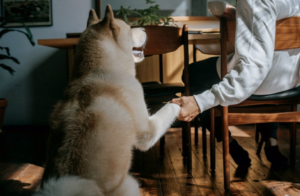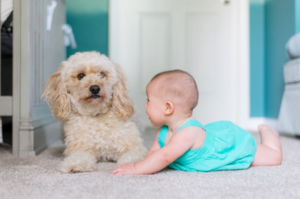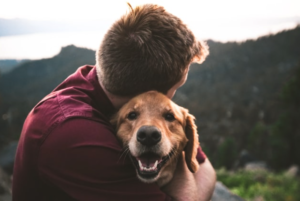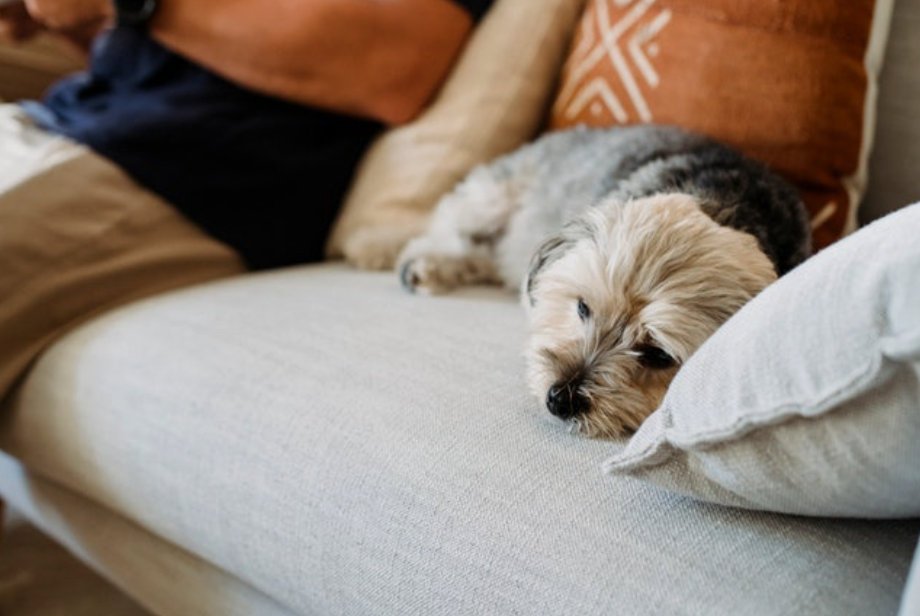You return home and discover chaos. Torn pillows, feathers, ripped shoes in the middle of the room, and, in the center of the crime scene – your pet with your shirt still in his mouth. What dog owner hasn’t gone through a story like this? And it can be even graver – a wet carpet and a gift on the bed. If something like this has happened to you, it is a clear sign that you urgently need to change your attitude since it is very likely that your dog is feeling some tension! To help you along with your mission, here are a few ways to recognize stress in dogs and a few tips on how to overcome this feeling.
Don’t Shout at the Dog
Most owners immediately start reprimanding their dogs by shouting at them after walking in on an unsuccessful redecorating attempt. On the lowest form of expression is an opinion (the dog is naughty, bad, wrong, poorly behaved), a moderate response is a reaction as well which could express itself as a resentment, frustration, clenching or tightening of certain body parts including shortening of breaths. And lastly, a highly reactive (not a responsive) behavior can be even to throw their pet out of the house or lock it in the bathroom or some other punitive consequence. Such reactions are understandable but completely pointless and even harmful from the aspect of dog psychology.
If the owner punishes the dog after they come home, the dog will associate the punishment with the owner’s arrival. This will lead to fear, even at the sound of a car or the front door opening. However, the dog will never realize that the punishment is related to the damage. So, instead of reacting hastily, try to understand your dog was in a nervous state. The damage that occurred is simply a result of him looking for a way to soothe and overcome fear.
Owner – Alpha Dog
When a dog is left alone at home, owners usually routinely give instructions to their pet, telling him how good he should be to avoid getting punished. The dog does not understand the meaning of the words, but all non-verbal messages, facial expressions, gestures, and the tone in which the owner addresses him are clear. In such situations, the dog concludes that the owner is worried, upset, and insecure about something.
The dog sees his human as the pack leader – the alpha. That is why all your anxiety and fear strongly reflect on the dog as a lower pack member. Once you leave the house, your dog will be alone and exposed to a tremendous amount of stress. Pups that suffer from separation anxiety immediately fall into a crisis after their owner’s departure.
Excessive Attachment
The symptoms of stress are different for each animal. Dogs usually start howling first, then barking. Finally, a destructive phase occurs when every object in the dog’s environment gets demolished. In the worst-case scenario, defecates around the house can also happen.
If the owner of an anxious dog goes on a long trip, for example, and leaves him to a friend, the situation becomes even more complicated. Pets are not used to spending time alone, and stress comes as a consequence. The dog may even experience a complete loss of appetite, bloody stools, and visible depression.

The bond between dogs and their owners is really special and impactful.
This signifies an excessive emotional attachment of the dog to its owner, i.e., the lack of independence as a vital prerequisite for normal development. Usually, between 8 and 12 weeks of age, a puppy becomes attached to its new owner – the person who feeds it and pays the most attention to it. This creates an affective bond that develops even more when the puppy grows up and causes a high attachment to the owner.
To avoid such, to put it mildly, unpleasant situations often dangerous for the dog, the owner should get their puppy used to his absence in time. A trained canine will develop a better system of defense against stress.
The 5 Most common Causes of Stress
1. Fear
Fear is the most common cause of pet stress. As with humans, fear is a negative emotion that causes many changes. Fear can be fueled by other animals, people, objects, weather conditions, etc.
2. Anxiety
It is a well-known fact that anxiety causes stress. However, it’s less known that there are several types of anxiety.
- Anxiety caused by separation
- Social anxiety
- Noise-induced anxiety
In this case, the most attention should be paid to the anxiety caused by noise, which can lead to great fear and stress in the dog. If you learn to cope with your dog’s anxiety, his stress levels are bound to improve.
3. Lifestyle Changes
In addition to excessive attachment to their master, there are many other stress triggers in dogs. Disturbing harmony in the family (pack) due to the departure of one of its members (death of another animal, going away to school, divorce, death in the family, etc.) is a common cause of stress. The most extreme case is the death of the owner. Many dogs then become severely depressed, often to the point of dying of grief.

Bringing a new baby home can have a big impact on the dog.
The arrival of a new member of the family also causes stress in the dog. However, this can be easily resolved. It is enough for the dog to spend some time in the room prepared for the newborn before the baby comes home, to smell the toys, bedding, and the baby’s clothes. One diaper should be brought from the hospital and given to the dog to sniff so that the baby’s smell becomes familiar.
Another significant lifestyle change is moving with your pet or changing a home. You will need to put special thought into this project and prepare them for this stressful event, making sure they are comfortable and well taken care of.
Improper Ways of Training
Dog training is a skill to master. It can be fun and highly beneficial to your dog’s mental and physical health, but it can also cause anxiety and bad outcomes if not executed properly.
Wrong ways to train dogs include:
- Use of shock collar
- Inflicting physical injuries
- Shouting
These methods generate immense stress and poor mental state of the puppy.
Invasion of dog’s Personal Space
You most likely know that entering a personal space signifies an attack in the animal world. Namely, when a child or another person tries to hug or pet a dog, he could perceive this as an invasion of space. This is a situation that sometimes causes aggression, fear, and stress. To prevent any disastrous consequences, you must monitor how your child or other people treat your dog.
Recognize Stress in Dogs – the Symptoms
To cope with the unbearable amount of stress, dogs use various methods of defense, which result in the appearance of a whole series of easily noticeable symptoms. In the beginning, dogs usually fall into a state of pre-depressive fear, which physically manifests through clear reactions, such as constant licking of a particular body part or obsessive biting of the paw, which can cause eczema or granulomas.
In later, more severe stages, other symptoms also appear. Defecation inside the house, eating and sleep disorders, swallowing stones, pieces of wood, plastic, and other objects are just a few.
So, a list of common symptoms would be:
- Excessive shedding
- Aggression
- Constant barking
- Whining and howling
- Destructive behaviors
- Diarrhea or constipation
- Excessive salivation
- Loss of appetite
- Excessive scratching
- Pacing
- Tail between legs
- Shivering
How to Reduce the Impact of Stress on your Dog?
To reduce the impact of stress on our dogs, it is necessary to understand their behavior and learn what they are trying to tell us (how they feel and what they want). Recognize when and if something is too hard for them, what excites them, if they are tired, and if something might be hurting them.

Recognizing your dog’s behavior patterns will lead to a happier pet.
When we learn to recognize which things or situations are harder to deal with, it will be much easier to react adequately – to remove the dog from the situation or environment that is too stressful for him or change our behavior towards the dog. It is also essential to know the difference between excitement and stress-induced behavior.
Help Your Dog
Socialization is also crucial. We need to help the dog learn how to deal with everyday situations that are bound to occur. By socializing, we improve and strengthen their self-confidence. In addition to all that, it is essential to think about whether our desires and ambitions are worth putting our pets in situations that are not so pleasant for them, such as playing sports and various cynological disciplines. Our goal should be fun and enjoyment in each other’s company, something far more valuable than any awards and cups.
Dogs don’t ask for much. For them, the most important thing is to have food and water, use their instincts, have company, time for rest, and time for play. So, remember the ways to recognize stress in dogs and make sure you are always there for your four-legged friend.
Now that you have some clues as to the main stress factors canines face, hone in on the most effective ways to address hyperactivity in your dog.
Images used:
https://www.pexels.com/photo/cute-purebred-dog-on-comfortable-sofa-5424645/
https://www.pexels.com/photo/fluffy-purebred-dog-giving-paw-to-crop-man-drinking-coffee-at-table-5749112/
https://unsplash.com/photos/EScCHx_ZR8Y
https://unsplash.com/photos/ISg37AI2A-s
Love our content? Share it with a friend or link it to social media. Like short clips of cute household pets? Training tips? Follow us on instagram @nydognanny or on YouTube at nydognanny. Have some news you needs to get to dog and cat parents stat? Email info@newyorkdognanny.com with your article pitch.




